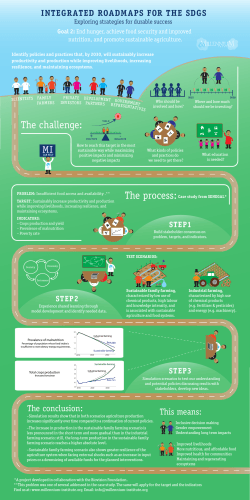
Appendix 4 - Partnership for Housing Affordability
Appendix 4 Several factors will influence future housing demand in the region, including population growth, employment, income trends, and consumer preferences for housing types and locations within the region. Among these, population growth is possibly the most important factor affecting housing demand. Population growth, and most importantly, net migration into or out of an area reflect employment opportunities for people in the labor force. Younger and early-middle age workers are the most likely to move toward job opportunities. Housing demand is heavily influenced by a person’s age and the likelihood of being a ‘householder’ (the person identified as being primarily responsible for the housing unit) increases as we move into the middle adult years. Younger adults, including those in their teens, are more likely to be dependents in someone else’s house (mainly their parents) and do not start forming their own households, until they are into their early twenties. Older adults are more likely to be in their own households. By definition, a household is an occupied housing unit, so there is a 1-to-1 equivalence between households and housing demand. This study utilizes two alternative projection scenarios for future housing demand in the region. Neither of these projections ‘knows’ the future—their accuracy depends on the accuracy of their assumptions about the future. Both scenarios use the same assumption about how many housing units are associated with adults based on their age group: the percent of householders (and thus occupied housing units) for ten-year age categories starting with 15-24 year olds and ending with 85+ year olds as reported in the 2010 Census is assumed to remain constant for 2020 and 2030. Although age-specific householder rates are reasonably stable, they will change as personal preferences and incomes change. If in any given age group, more (or fewer) people share housing units with others (whether as spouses, roommates, extended families or other relationships), then there will be fewer (or more) housing units in demand. If the economic conditions and preferences shaping age-specific housing demand in 2010 change significantly by 2020 or 2030, these housing demand scenarios will need to be adjusted accordingly. The major difference in the two scenarios is in the time period used to establish the trend in changes in ‘birth cohorts’. Birth cohorts follow the same age cohort across time. For example, the 25-34 year old age group in 2000 as a birth cohort became the 35-44 year age group in 2010. The only changes that occur in the size of a birth cohort are due to deaths and net migration (the difference between the number of people in the birth cohort moving into a community and the number moving out). Since age-specific death rates are fairly stable in the United States, population projections mainly differ due to their assumptions about migration. Scenario A assumes that the pattern of growth in ‘birth cohorts’ between 2000 and 2010 for each jurisdiction will stay constant across 2010-2020 and 2020-2030, whereas Scenario B uses a population projection that relies on the trend from 1950 through to 2010 to project total population into the future and on the average Cohort Change Ratio for 1990 to 2000 and 2000 to 2010. Scenario B uses the age-specific population projections published by the Weldon Cooper Center at the University of Virginia, but substitutes Chesterfield County’s own projections for that county. Scenario A uses Cohort Change Ratios for 2000 to 2010. The population projections used in Scenario B were controlled for state totals, whereas the population projections used in Scenario A do not control for any higher level of aggregation. Scenario A depends entirely on the 2000-2010 growth patterns to be constant at the jurisdiction level, whereas Scenario B relies on trends established over a longer period and controls to state totals (with the exception of Chesterfield County which uses the County’s own projection). Scenario A forecasts significant growth in housing demand across the region, but the primary growth areas are Chesterfield, Henrico, Richmond and Hanover (in order of growth). In this Scenario, Chesterfield accounts for 38% of the region’s housing demand growth over the twenty-year period, with Henrico, Richmond and Hanover accounting for 29%, 14% and 8% respectively. Nearly 90% of the growth in housing demand is in these four jurisdictions and with 80% in the first three. Across the region, the demographic segment with the most growth is senior housing. The 65 and older age group accounts for 58% of increased housing demand in Scenario A and 67% in Scenario B. Most of this growth is due to aging of the baby-boom cohort already living in the region, and the impact on demand for new housing will depend on a variety of factors including consumer preferences and incomes. But an increase in the number of 65 and older householders in the region between 66,000 (Scenario B) and 77,000 (Scenario A) from 2010 to 2030 will undoubtedly have a substantial impact on the demand for housing and housing related services. The youngest age group (under 25) accounts for very little growth in both scenarios, but 25-34 year olds are projected to increase by 15,000 (Scenario B) to 18,000 households (Scenario A). If the more recent trend established for location choice among this age group prevails, this growth would result in a significant increase in demand in the City of Richmond (as reflected in the Scenario A projection). If longer term growth rates and location preferences prevail, there will be less demand from this age group overall, but particularly for Richmond. In many ways the economic shock of the Great Recession dealt young adults a serious blow, but whether and how much young adult housing demand will bounce back in the future remains to be determined. If incomes, housing costs and preferences become more favorable for household formation by young adults over the projection period, the growth in demand for this segment should be even higher. For example, at the rate of young adult household formation in the year 2000 (rather than 2010 rate), there would be an additional 9,000 housing units needed for young adults (under age 35). The region is also expected to have significant expansion in the 35-44 year householder segment, which is projected to increase by 18,000 to 26,000 households. Incomes, family status, and life-styles are expected to boost demand for owner-occupied housing, particularly for first-time buyers, in this age group. The slowest growing market segment is for householders aged 45 to 64, which is only projected to increase by 7,700 region-wide in Scenario A and is projected to contract by 1,100 in Scenario B. Additionally both Scenarios project contraction in this segment for the City of Richmond. As this age group is traditionally where homeownership demand for larger and more expensive housing is very high, the housing market could experience a significant shift toward the preferences of younger and of older age groups. Table 1: Change in Housing Demand (Occupied Units) by Age of Householder 2010 to 2030, Scenario A Age Chesterfield County Henrico County City of Richmond Charles City Co. <25 1,057 1,529 501 (16) 25-34 3,598 (81) 12,536 35-44 10,733 7,762 45-54 2,656 55-64 65-74 Goochland County Hanover County New Kent County Powhatan RRPDC County 39 118 64 41 3,334 (48) 93 1,557 191 547 18,394 5,453 (66) 267 792 796 123 25,861 1,035 (2,317) (233) (165) (2,221) 284 (408) (1,369) 3,472 4,687 (2,624) (109) 824 1,161 783 922 9,115 13,717 13,435 4,239 395 1,873 5,148 1,870 2,015 42,691 75+ 14,503 9,428 848 364 1,349 4,373 1,238 1,732 33,835 Total 49,735 37,795 18,637 288 4,279 10,928 5,227 4,972 131,862 Chart 1: Housing Demand Projection Scenario A, Charles City, Goochland, Hanover, New Kent, Powhatan Counties: 2010, 2020, 2030 50,000 40,000 30,000 20,000 10,000 0 2010 2020 2030 2010 2020 2030 2010 2020 2030 2010 2020 2030 2010 2020 2030 Charles City Goochland Hanover 15-34 35-64 New Kent Powhatan >65 Chart 2: Housing Demand Projection Scenario A, Chesterfield, Henrico, Richmond: 2010, 2020, 2030 175,000 150,000 125,000 100,000 75,000 50,000 25,000 0 2010 2020 2030 2010 Chesterfield 2020 2030 Henrico 15-34 35-64 2010 2020 Richmond >65 2030 Table 2: Change in Housing Demand (Occupied Units) by Age of Householder 2010 to 2030, Scenario B Age <25 Chesterfield Henrico County County City of Charles Richmond City Co. Goochland Hanover New Powhatan RRPDC County County Kent County County 8 174 11 19 263 177 1,574 (1,696) (5) 25-34 3,821 8,292 (1,150) 5 260 2,649 229 617 14,724 35-44 3,305 6,493 5,247 18 (30) 2,742 328 189 18,292 45-54 (2,286) 92 (1,597) (118) (541) (993) (229) (638) (6,309) 55-64 1,153 3,430 (2,541) 37 331 2,071 154 541 5,174 65-74 12,466 11,775 4,119 512 1,289 5,459 1,011 1,409 38,041 75+ 11,305 8,652 1,097 374 954 4,192 751 1,057 28,382 Total 29,941 40,308 3,479 822 2,271 16,295 2,255 3,195 98,565
© Copyright 2026









